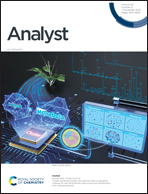Electrochemical sensor propelled by exonuclease III for highly efficient microRNA-155 detection †
Abstract
MicroRNA-155 is highly expressed in tumor cells such as lung cancer, liver cancer and lymphoma. As such, it is increasingly used for the early diagnosis and monitoring of cancer diseases. Herein, we designed an electrochemical sensor propelled by exonuclease III, which is coupled with multiple signal amplification strategies for highly efficient microRNA-155 detection. In the presence of miRNA-155, a DNA hairpin probe with exposed bases at both ends was found to form a flat end, which can be hydrolyzed by exonuclease III. The produced single-stranded DNA enters the next cycle for further cleavage to produce another single-stranded DNA. The end product can trigger a hybridization chain reaction on the electrode surface, which is used for electrochemical detection with methylene blue as an electrochemical signaling indicator. Under optimal reaction conditions, there is good linear correlation between the logarithm of the target concentration and the current signal, with the concentration ranging from 0.1 fM to 0.1 nM. The detection limit is as low as 0.035 fM. Overall, the strategy for miRNA detection offers good prospects for early cancer screening.



 Please wait while we load your content...
Please wait while we load your content...